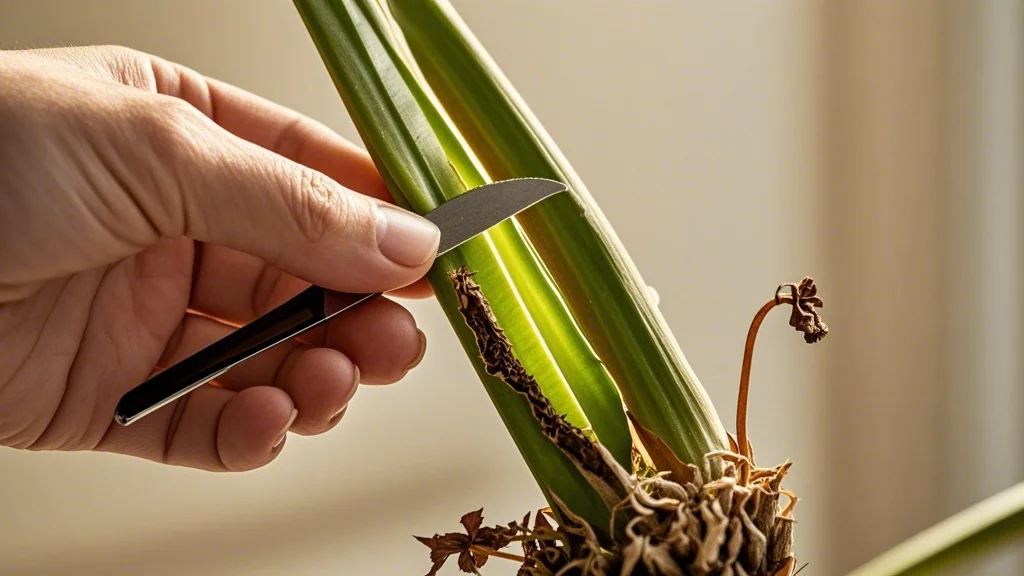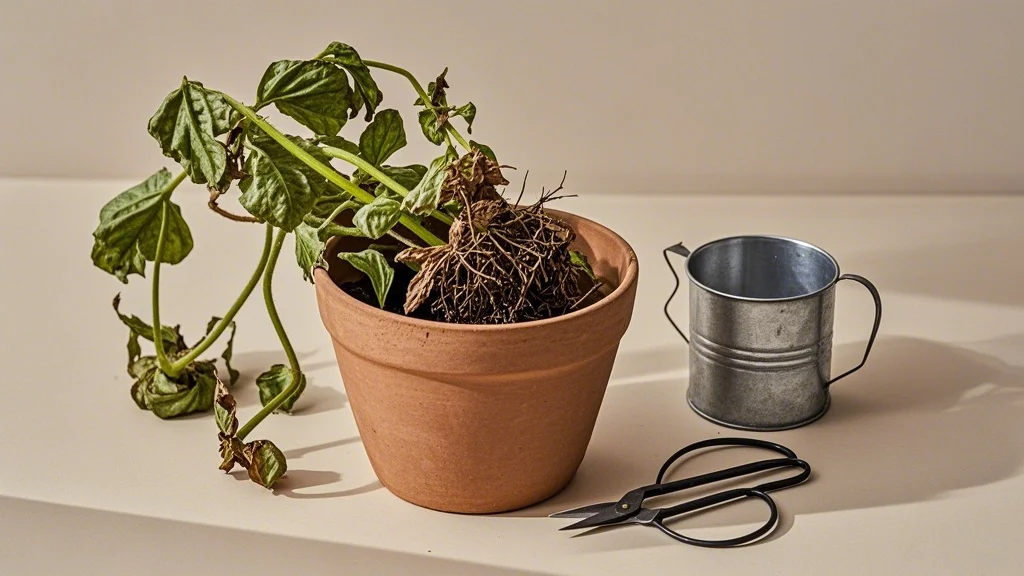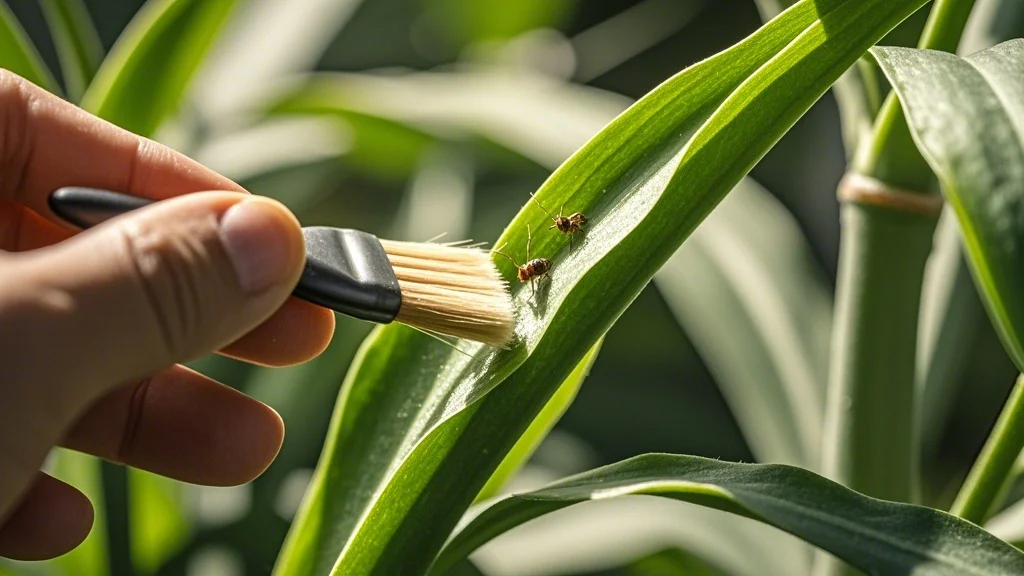For plant enthusiasts, admitting defeat can be one of the hardest aspects of indoor gardening. We form emotional connections with our green companions, investing time, effort, and hope into their care. However, recognizing when a plant is truly beyond saving is an essential skill that saves resources, emotional energy, and makes room for new growth. This article will help you identify when revival attempts are futile and guide you through the process of respectfully disposing of plants that have reached their end.
Contents
- 1 Basic Concepts: Understanding Plant Death
- 2 Scientific Principles: Understanding Plant Death Processes
- 3 Practical Assessment Basics: Is It Really Dead?
- 4 Plant Differences in Recovery Potential
- 5 Seasonal Considerations in Plant Death Assessment
- 6 Common Plant Death Scenarios and Solutions
- 7 Respectful Plant Disposal
- 8 Frequently Asked Questions
- 9 Conclusion: Embracing the Full Cycle of Plant Care
Basic Concepts: Understanding Plant Death
Key Terms Explained
-
Plant death: The permanent cessation of all biological functions that sustain a plant
-
Dormancy: A temporary state of reduced metabolic activity, often mistaken for death
-
Root rot: Fungal disease that causes roots to decay, often fatal if extensive
-
Necrosis: Death of plant tissue, typically visible as browning or blackening
Common Misconceptions Clarified
Many plant owners struggle to distinguish between a dead plant and one that’s merely stressed or dormant. A leafless plant isn’t necessarily dead—many species shed leaves during dormant periods. Conversely, a plant with some green leaves may still be beyond saving if the root system has failed.
The most persistent misconception is that any plant can be revived with enough care. Unfortunately, once certain thresholds are crossed—extensive root rot, complete vascular system failure, or severe pest infestation—recovery becomes impossible.
Why Recognition Matters
Properly identifying truly dead plants allows you to:
- Prevent spread of diseases to healthy plants
- Reallocate limited resources (time, space, emotional energy)
- Learn valuable lessons for future plant care
- Make room for new, viable plants
Scientific Principles: Understanding Plant Death Processes
How Plants Respond to Fatal Damage
Plants have remarkable resilience, but they operate within biological limits. When a plant experiences severe stress, it typically follows a predictable decline pattern:
- Reduced growth and vigor
- Yellowing or browning of leaves
- Leaf drop
- Stem death
- Root system failure
This cascade can be triggered by various factors, but once the vascular system (the plant’s circulatory system) fails or the roots die completely, recovery becomes impossible.
Environmental Factors in Plant Death
Several environmental conditions can push plants beyond the point of no return:
-
Extreme temperature shock: Cellular damage from freezing or extreme heat
-
Prolonged drought: Complete desiccation of tissues
-
Overwatering: Oxygen deprivation and root rot
-
Light deprivation: Energy production failure
-
Severe pest infestation: Destruction of vital tissues
Special Considerations for Indoor Gardening
Indoor plants face unique challenges that can accelerate decline:
- Limited root space restricting recovery potential
- Artificial lighting that may be insufficient for energy needs
- Controlled but potentially inappropriate humidity levels
- Restricted air circulation increasing disease susceptibility
- Accumulated fertilizer salts causing root burn
Practical Assessment Basics: Is It Really Dead?

Evaluation Methods and Techniques
To determine if your plant is truly beyond saving, perform these systematic checks:
-
The scratch test: Gently scratch the main stem with your fingernail. Green, moist tissue underneath indicates life; brown, dry tissue suggests death.
-
Root examination: Carefully remove the plant from its pot and inspect the roots. Healthy roots are firm and typically light-colored (white, tan, or light brown depending on species). Dead roots are mushy, dark brown or black, and often emit a foul odor.
-
Stem flexibility: Living stems bend; dead stems snap cleanly.
-
Bud inspection: Check for living buds along stems, which indicate potential for new growth.
-
Overall assessment: If more than 80% of the plant shows signs of death (no green tissue, rotted roots, brittle stems), recovery is unlikely.
Setting Reasonable Expectations
Different plants have varying recovery abilities:
- Succulents can often regenerate from a single healthy leaf
- Woody perennials may regrow from the root system even when all above-ground growth appears dead
- Delicate tropicals typically have lower recovery rates from severe decline
Give plants appropriate recovery time—sometimes weeks or even months—before declaring them definitively dead, especially if you see even small signs of life.
Basic Tools for Assessment
Keep these tools handy for proper evaluation:
- Clean, sharp pruners for testing stems
- Magnifying glass for examining small buds or pests
- Clean container for root washing and examination
- Camera for documenting progression (useful for learning)
Plant Differences in Recovery Potential
High-Recovery Plants: Characteristics and Examples
Some plants demonstrate remarkable resilience and should be given extra time before being declared dead:
-
Snake plants (Sansevieria): Can regenerate from small sections of healthy rhizome
-
ZZ plants (Zamioculcas zamiifolia): Survive extreme neglect and regrow from tubers
-
Pothos (Epipremnum aureum): Can regenerate from stem cuttings with nodes
-
Spider plants (Chlorophytum comosum): Produce plantlets that can survive even when the mother plant fails
These plants often appear dead above soil but maintain viable underground structures.
Medium-Recovery Plants: Characteristics and Examples
These plants have moderate recovery potential if the damage isn’t too extensive:
-
Peace lilies (Spathiphyllum): Can recover from wilting but not from complete root rot
-
Philodendrons: Resilient but susceptible to complete failure if stems rot
-
Ficus species: Can resprout from woody parts but may not recover from severe leaf drop
-
Dracaena: Can regenerate from stem cuttings if the main plant fails
Low-Recovery Plants: Characteristics and Examples
Some plants have minimal recovery potential once they show significant decline:
-
Maidenhair ferns (Adiantum): Rarely recover once fronds crisp
-
Calathea/Maranta: Often fail completely once leaves curl and crisp
-
Orchids: Difficult to revive once pseudobulbs shrivel or roots completely die
-
Air plants (Tillandsia): Rarely recover from severe dehydration or rot
Seasonal Considerations in Plant Death Assessment
Growing Season Management
During active growth periods (typically spring and summer), healthy plants should show clear signs of life:
- New leaf development
- Elongating stems
- Visible root growth
- Response to fertilization
A plant showing no signs of growth during its natural growing season after 4-6 weeks of proper care is likely dead or in severe decline.
Dormancy Period Management
Many plants naturally enter dormant periods where they may appear dead:
- Deciduous plants often drop leaves
- Growth slows or stops completely
- Water needs decrease dramatically
- Plants may retreat to bulbs, rhizomes, or tubers
During these periods, withhold judgment unless clear signs of decay (mold, mushiness, foul odor) are present.
Seasonal Transition Adjustments
Be particularly careful when assessing plants during seasonal transitions:
- Early spring may show slow awakening from dormancy
- Late fall may show natural decline into dormancy
- Sudden seasonal changes can trigger temporary stress responses
Common Plant Death Scenarios and Solutions
Scenario 1: Complete Leaf Drop
Symptoms:
- All leaves have fallen off
- Stems remain firm and pass the scratch test
Assessment: Potentially salvageable
Solution:
- Check roots for health and trim any rotted sections
- Place in appropriate light conditions
- Water sparingly until new growth appears
- Be patient—regrowth may take weeks or months
Scenario 2: Root Rot
Symptoms:
- Yellowing/wilting leaves despite moist soil
- Foul smell from soil
- Dark, mushy roots when examined
Assessment: Potentially salvageable only if some healthy roots remain
Solution:
- Remove plant from soil and wash roots gently
- Cut away all dark, mushy roots with sterile scissors
- Repot in fresh, well-draining soil
- If no healthy roots remain, the plant is likely beyond saving
Scenario 3: Crispy, Brown Foliage
Symptoms:
- All leaves brown and crispy
- Stems brittle or failing scratch test
- No signs of new growth points
Assessment: Likely dead, especially if condition persists for weeks
Solution:
- Check for any green tissue in stems or crown
- If none found, the plant is dead and should be discarded
- If minimal green tissue exists, cut back to this point and provide optimal care
Respectful Plant Disposal

When you’ve confirmed a plant is truly dead, consider these respectful disposal methods:
Composting
For plants that died of natural causes or non-infectious issues:
- Remove from container
- Break down larger woody parts
- Add to compost bin or pile
- Return pot to service after cleaning
Special Handling for Diseased Plants
For plants that died from disease or pest infestation:
- Seal in plastic bag before removing from growing area
- Do not compost—dispose in regular trash
- Clean and disinfect the pot with 10% bleach solution
- Quarantine and monitor nearby plants
Learning from Loss
Before disposing of a dead plant:
- Take photos for reference
- Note care conditions that preceded death
- Research specific issues that may have contributed
- Apply lessons to future plant care
Frequently Asked Questions
Q: How long should I wait before declaring my plant dead?
A: This varies by species, but generally, if a plant shows no response to appropriate care for 4-6 weeks during its growing season, it’s likely dead. Woody plants and those with underground storage organs may need longer—up to 2-3 months—before being declared truly dead.
Q: Can a plant with no leaves but green stems recover?
A: Yes, many plants can regenerate from stems if they still contain green, living tissue. As long as the stem passes the scratch test (revealing green tissue underneath) and the roots are not completely rotted, recovery is possible.
Q: Is it worth trying to save a plant with 90% dead roots?
A: Rarely. Plants with more than 70-80% root loss have very low survival rates. However, if the plant has special significance, you can try extreme measures: cutting back all foliage to reduce water needs, creating a humidity chamber, and using rooting hormone on remaining healthy tissue.
Q: Can a completely brown plant come back to life?
A: It depends on where the browning occurs. If only leaves are brown but stems remain green inside (check with the scratch test), recovery is possible. If stems are brown and brittle throughout, the plant is dead.
Q: Should I be concerned about diseases from dead plants?
A: Yes. Dead and decaying plant material can harbor pathogens and pests that may spread to healthy plants. Always isolate declining plants and properly dispose of dead ones, especially if disease is suspected.
Conclusion: Embracing the Full Cycle of Plant Care
Recognizing when a plant is truly beyond saving is as important a skill as knowing how to nurture growth. By understanding the signs of irreversible decline, you can make informed decisions about when to redirect your efforts toward new green companions.
Remember these key points:
- Use systematic assessment methods rather than emotional responses
- Consider the specific recovery potential of different plant species
- Account for seasonal dormancy before declaring a plant dead
- Learn from each loss to improve your overall gardening skills
- Practice respectful disposal that honors the plant’s contribution to your space
The ability to let go of plants that have completed their lifecycle makes room for new growth and experiences in your indoor garden. While saying goodbye to a plant companion can be difficult, it’s a natural part of the gardening journey that ultimately strengthens your connection to the living world around you.









